Governance, Ethics, and Sustainability Assessment: Timberwell Report
VerifiedAdded on 2023/04/19
|11
|3128
|295
Report
AI Summary
This report provides a sustainability assessment of Timberwell Constructions, a residential development company, based on the GRI Sustainability Reporting Standards 2016. The assessment covers economic, environmental, and social sustainability aspects. Economically, it addresses financial implications of climate change, confirmed incidents of corruption, and legal actions related to anti-competitive behavior. Environmentally, the report examines energy consumption, impacts on biodiversity, and non-compliance with environmental regulations. Socially, it evaluates new employee hires, employee turnover, incidents of discrimination, and community engagement. The report highlights challenges such as employee turnover and discrimination, while also discussing the company's efforts to mitigate environmental impacts and engage with the local community. The report also emphasizes the importance of sustainable business practices for long-term corporate goals.
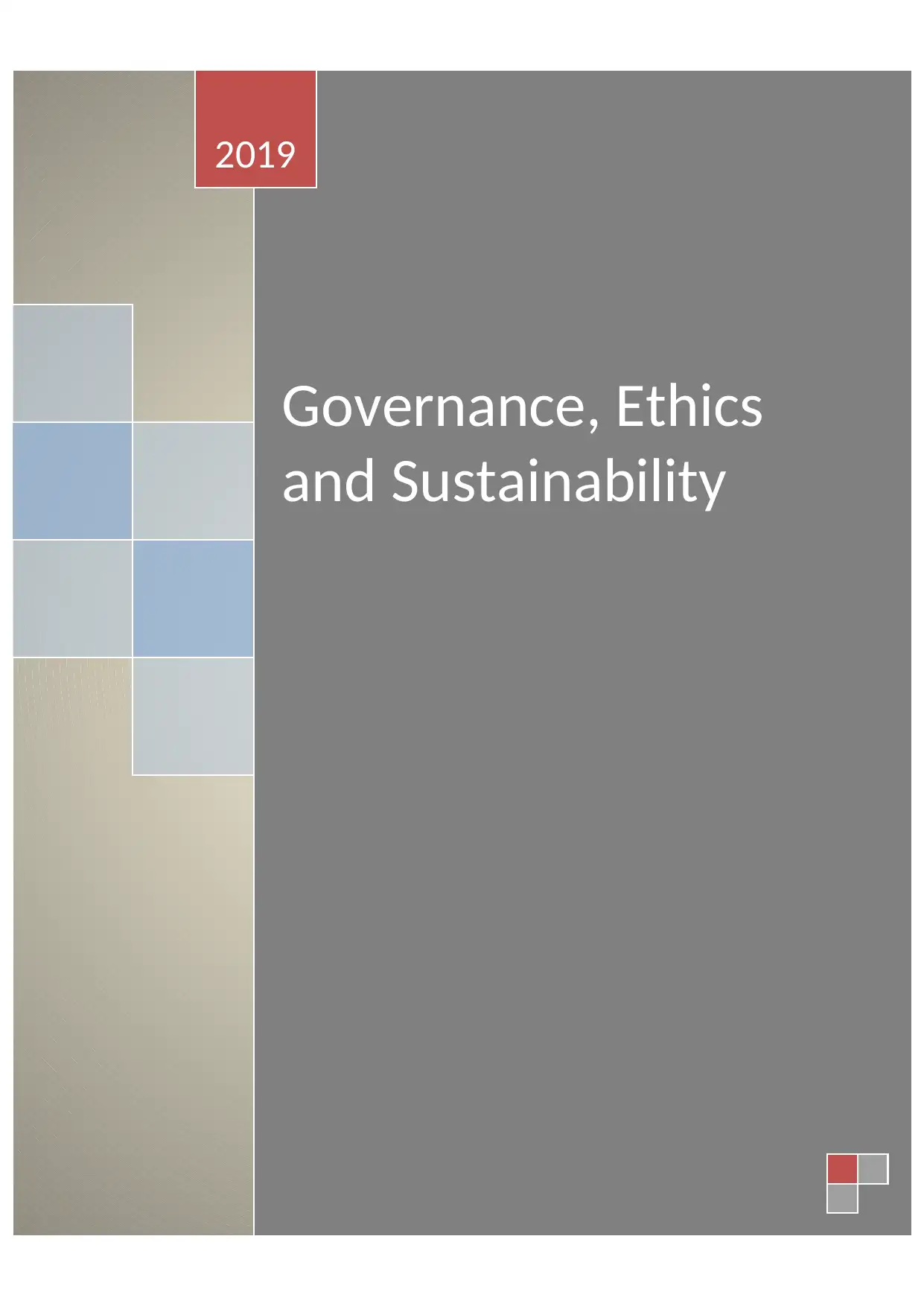
Governance, Ethics
and Sustainability
2019
and Sustainability
2019
Paraphrase This Document
Need a fresh take? Get an instant paraphrase of this document with our AI Paraphraser
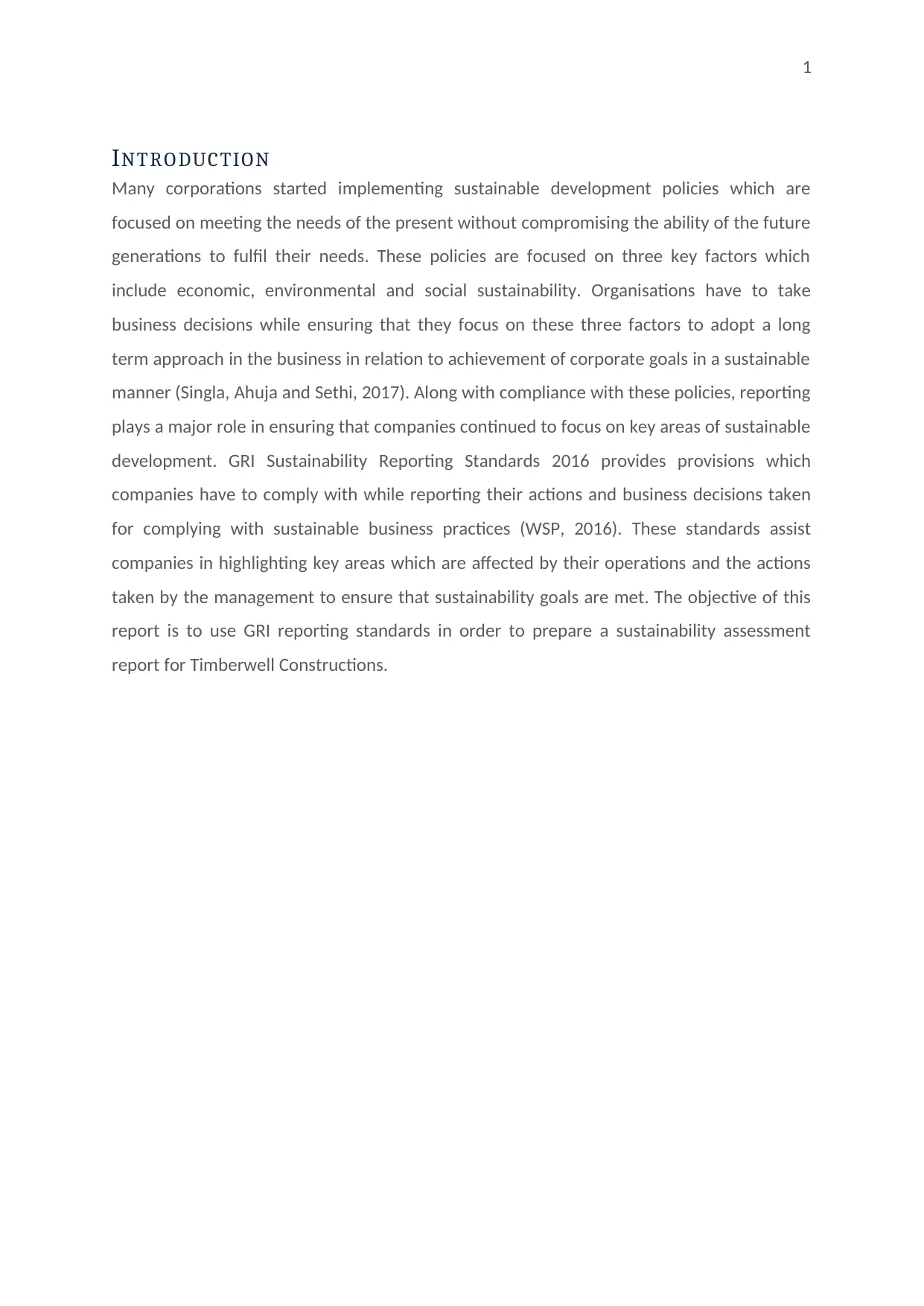
1
INTRODUCTION
Many corporations started implementing sustainable development policies which are
focused on meeting the needs of the present without compromising the ability of the future
generations to fulfil their needs. These policies are focused on three key factors which
include economic, environmental and social sustainability. Organisations have to take
business decisions while ensuring that they focus on these three factors to adopt a long
term approach in the business in relation to achievement of corporate goals in a sustainable
manner (Singla, Ahuja and Sethi, 2017). Along with compliance with these policies, reporting
plays a major role in ensuring that companies continued to focus on key areas of sustainable
development. GRI Sustainability Reporting Standards 2016 provides provisions which
companies have to comply with while reporting their actions and business decisions taken
for complying with sustainable business practices (WSP, 2016). These standards assist
companies in highlighting key areas which are affected by their operations and the actions
taken by the management to ensure that sustainability goals are met. The objective of this
report is to use GRI reporting standards in order to prepare a sustainability assessment
report for Timberwell Constructions.
INTRODUCTION
Many corporations started implementing sustainable development policies which are
focused on meeting the needs of the present without compromising the ability of the future
generations to fulfil their needs. These policies are focused on three key factors which
include economic, environmental and social sustainability. Organisations have to take
business decisions while ensuring that they focus on these three factors to adopt a long
term approach in the business in relation to achievement of corporate goals in a sustainable
manner (Singla, Ahuja and Sethi, 2017). Along with compliance with these policies, reporting
plays a major role in ensuring that companies continued to focus on key areas of sustainable
development. GRI Sustainability Reporting Standards 2016 provides provisions which
companies have to comply with while reporting their actions and business decisions taken
for complying with sustainable business practices (WSP, 2016). These standards assist
companies in highlighting key areas which are affected by their operations and the actions
taken by the management to ensure that sustainability goals are met. The objective of this
report is to use GRI reporting standards in order to prepare a sustainability assessment
report for Timberwell Constructions.
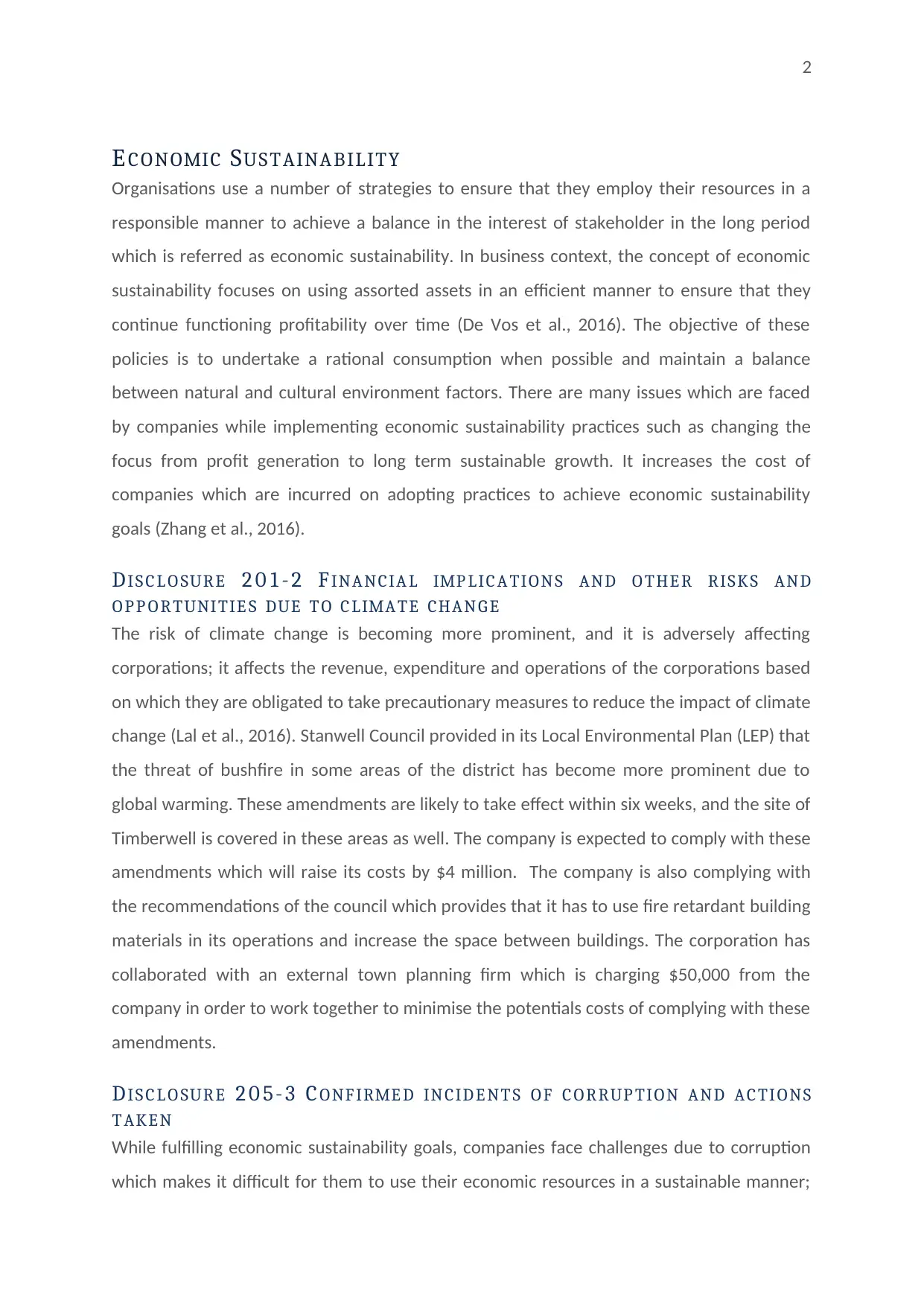
2
ECONOMIC SUSTAINABILITY
Organisations use a number of strategies to ensure that they employ their resources in a
responsible manner to achieve a balance in the interest of stakeholder in the long period
which is referred as economic sustainability. In business context, the concept of economic
sustainability focuses on using assorted assets in an efficient manner to ensure that they
continue functioning profitability over time (De Vos et al., 2016). The objective of these
policies is to undertake a rational consumption when possible and maintain a balance
between natural and cultural environment factors. There are many issues which are faced
by companies while implementing economic sustainability practices such as changing the
focus from profit generation to long term sustainable growth. It increases the cost of
companies which are incurred on adopting practices to achieve economic sustainability
goals (Zhang et al., 2016).
DISCLOSURE 201-2 FINANCIAL IMPLICATIONS AND OTHER RISKS AND
OPPORTUNITIES DUE TO CLIMATE CHANGE
The risk of climate change is becoming more prominent, and it is adversely affecting
corporations; it affects the revenue, expenditure and operations of the corporations based
on which they are obligated to take precautionary measures to reduce the impact of climate
change (Lal et al., 2016). Stanwell Council provided in its Local Environmental Plan (LEP) that
the threat of bushfire in some areas of the district has become more prominent due to
global warming. These amendments are likely to take effect within six weeks, and the site of
Timberwell is covered in these areas as well. The company is expected to comply with these
amendments which will raise its costs by $4 million. The company is also complying with
the recommendations of the council which provides that it has to use fire retardant building
materials in its operations and increase the space between buildings. The corporation has
collaborated with an external town planning firm which is charging $50,000 from the
company in order to work together to minimise the potentials costs of complying with these
amendments.
DISCLOSURE 205-3 CONFIRMED INCIDENTS OF CORRUPTION AND ACTIONS
TAKEN
While fulfilling economic sustainability goals, companies face challenges due to corruption
which makes it difficult for them to use their economic resources in a sustainable manner;
ECONOMIC SUSTAINABILITY
Organisations use a number of strategies to ensure that they employ their resources in a
responsible manner to achieve a balance in the interest of stakeholder in the long period
which is referred as economic sustainability. In business context, the concept of economic
sustainability focuses on using assorted assets in an efficient manner to ensure that they
continue functioning profitability over time (De Vos et al., 2016). The objective of these
policies is to undertake a rational consumption when possible and maintain a balance
between natural and cultural environment factors. There are many issues which are faced
by companies while implementing economic sustainability practices such as changing the
focus from profit generation to long term sustainable growth. It increases the cost of
companies which are incurred on adopting practices to achieve economic sustainability
goals (Zhang et al., 2016).
DISCLOSURE 201-2 FINANCIAL IMPLICATIONS AND OTHER RISKS AND
OPPORTUNITIES DUE TO CLIMATE CHANGE
The risk of climate change is becoming more prominent, and it is adversely affecting
corporations; it affects the revenue, expenditure and operations of the corporations based
on which they are obligated to take precautionary measures to reduce the impact of climate
change (Lal et al., 2016). Stanwell Council provided in its Local Environmental Plan (LEP) that
the threat of bushfire in some areas of the district has become more prominent due to
global warming. These amendments are likely to take effect within six weeks, and the site of
Timberwell is covered in these areas as well. The company is expected to comply with these
amendments which will raise its costs by $4 million. The company is also complying with
the recommendations of the council which provides that it has to use fire retardant building
materials in its operations and increase the space between buildings. The corporation has
collaborated with an external town planning firm which is charging $50,000 from the
company in order to work together to minimise the potentials costs of complying with these
amendments.
DISCLOSURE 205-3 CONFIRMED INCIDENTS OF CORRUPTION AND ACTIONS
TAKEN
While fulfilling economic sustainability goals, companies face challenges due to corruption
which makes it difficult for them to use their economic resources in a sustainable manner;
⊘ This is a preview!⊘
Do you want full access?
Subscribe today to unlock all pages.

Trusted by 1+ million students worldwide
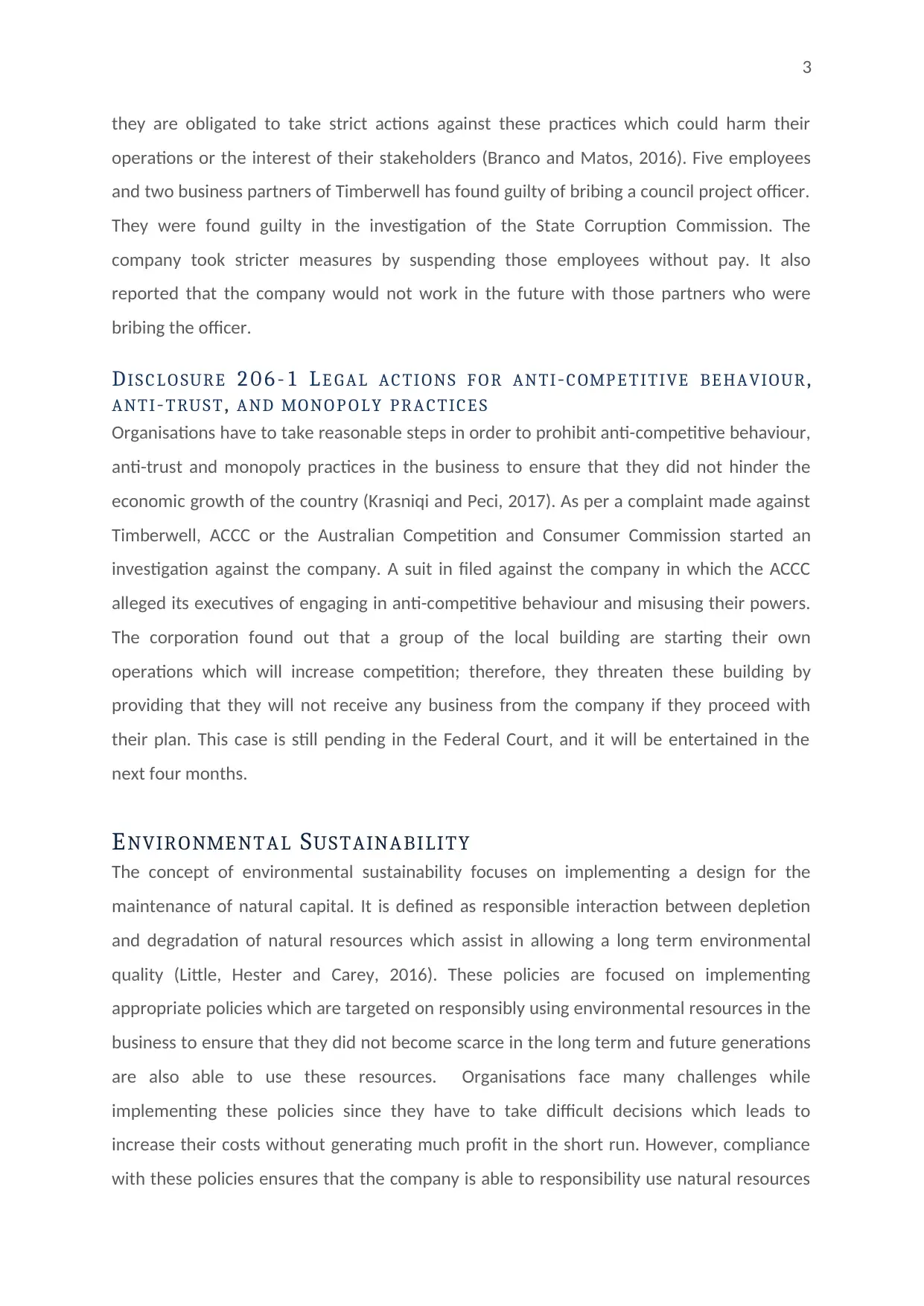
3
they are obligated to take strict actions against these practices which could harm their
operations or the interest of their stakeholders (Branco and Matos, 2016). Five employees
and two business partners of Timberwell has found guilty of bribing a council project officer.
They were found guilty in the investigation of the State Corruption Commission. The
company took stricter measures by suspending those employees without pay. It also
reported that the company would not work in the future with those partners who were
bribing the officer.
DISCLOSURE 206-1 LEGAL ACTIONS FOR ANTI-COMPETITIVE BEHAVIOUR,
ANTI-TRUST, AND MONOPOLY PRACTICES
Organisations have to take reasonable steps in order to prohibit anti-competitive behaviour,
anti-trust and monopoly practices in the business to ensure that they did not hinder the
economic growth of the country (Krasniqi and Peci, 2017). As per a complaint made against
Timberwell, ACCC or the Australian Competition and Consumer Commission started an
investigation against the company. A suit in filed against the company in which the ACCC
alleged its executives of engaging in anti-competitive behaviour and misusing their powers.
The corporation found out that a group of the local building are starting their own
operations which will increase competition; therefore, they threaten these building by
providing that they will not receive any business from the company if they proceed with
their plan. This case is still pending in the Federal Court, and it will be entertained in the
next four months.
ENVIRONMENTAL SUSTAINABILITY
The concept of environmental sustainability focuses on implementing a design for the
maintenance of natural capital. It is defined as responsible interaction between depletion
and degradation of natural resources which assist in allowing a long term environmental
quality (Little, Hester and Carey, 2016). These policies are focused on implementing
appropriate policies which are targeted on responsibly using environmental resources in the
business to ensure that they did not become scarce in the long term and future generations
are also able to use these resources. Organisations face many challenges while
implementing these policies since they have to take difficult decisions which leads to
increase their costs without generating much profit in the short run. However, compliance
with these policies ensures that the company is able to responsibility use natural resources
they are obligated to take strict actions against these practices which could harm their
operations or the interest of their stakeholders (Branco and Matos, 2016). Five employees
and two business partners of Timberwell has found guilty of bribing a council project officer.
They were found guilty in the investigation of the State Corruption Commission. The
company took stricter measures by suspending those employees without pay. It also
reported that the company would not work in the future with those partners who were
bribing the officer.
DISCLOSURE 206-1 LEGAL ACTIONS FOR ANTI-COMPETITIVE BEHAVIOUR,
ANTI-TRUST, AND MONOPOLY PRACTICES
Organisations have to take reasonable steps in order to prohibit anti-competitive behaviour,
anti-trust and monopoly practices in the business to ensure that they did not hinder the
economic growth of the country (Krasniqi and Peci, 2017). As per a complaint made against
Timberwell, ACCC or the Australian Competition and Consumer Commission started an
investigation against the company. A suit in filed against the company in which the ACCC
alleged its executives of engaging in anti-competitive behaviour and misusing their powers.
The corporation found out that a group of the local building are starting their own
operations which will increase competition; therefore, they threaten these building by
providing that they will not receive any business from the company if they proceed with
their plan. This case is still pending in the Federal Court, and it will be entertained in the
next four months.
ENVIRONMENTAL SUSTAINABILITY
The concept of environmental sustainability focuses on implementing a design for the
maintenance of natural capital. It is defined as responsible interaction between depletion
and degradation of natural resources which assist in allowing a long term environmental
quality (Little, Hester and Carey, 2016). These policies are focused on implementing
appropriate policies which are targeted on responsibly using environmental resources in the
business to ensure that they did not become scarce in the long term and future generations
are also able to use these resources. Organisations face many challenges while
implementing these policies since they have to take difficult decisions which leads to
increase their costs without generating much profit in the short run. However, compliance
with these policies ensures that the company is able to responsibility use natural resources
Paraphrase This Document
Need a fresh take? Get an instant paraphrase of this document with our AI Paraphraser
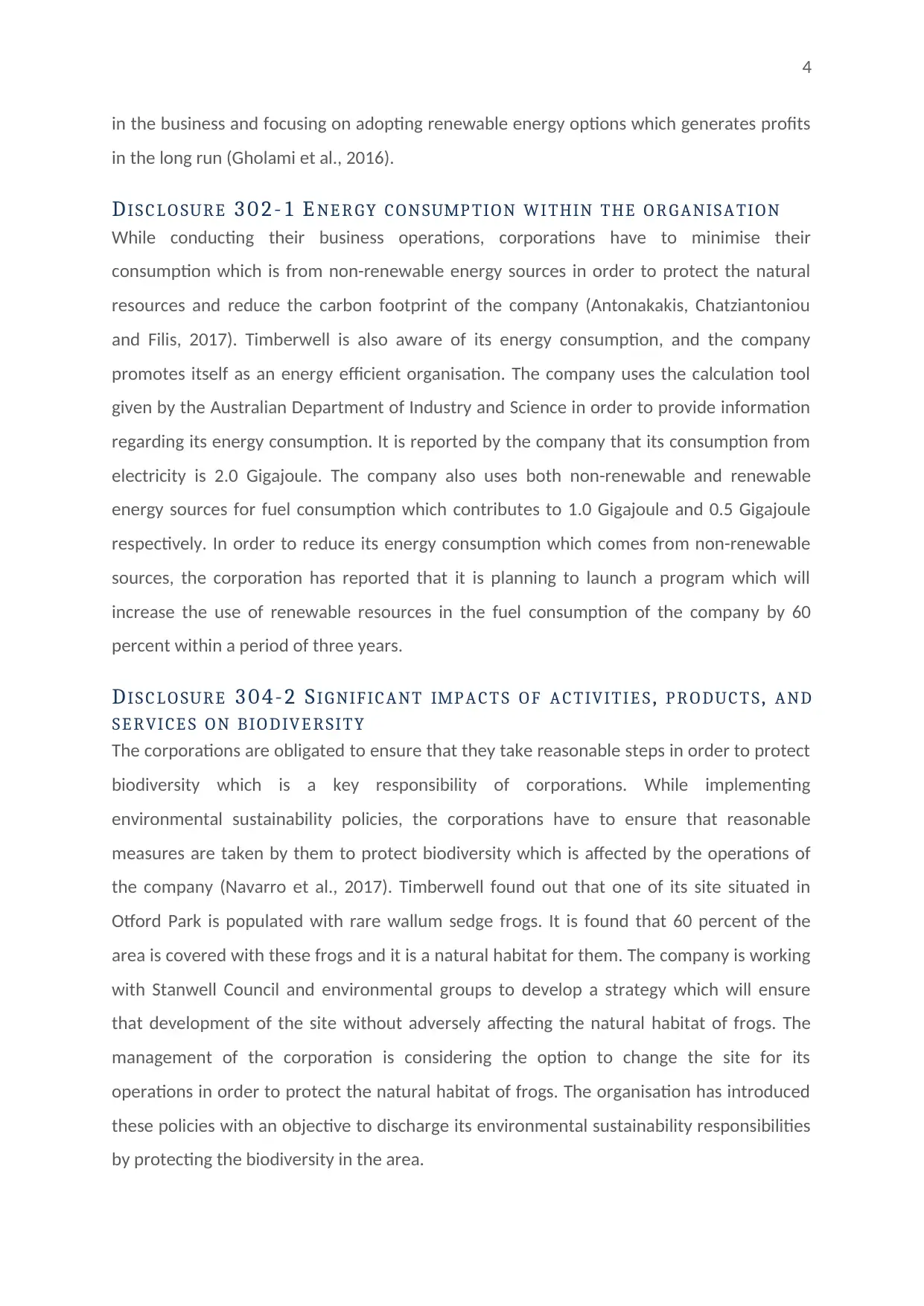
4
in the business and focusing on adopting renewable energy options which generates profits
in the long run (Gholami et al., 2016).
DISCLOSURE 302-1 ENERGY CONSUMPTION WITHIN THE ORGANISATION
While conducting their business operations, corporations have to minimise their
consumption which is from non-renewable energy sources in order to protect the natural
resources and reduce the carbon footprint of the company (Antonakakis, Chatziantoniou
and Filis, 2017). Timberwell is also aware of its energy consumption, and the company
promotes itself as an energy efficient organisation. The company uses the calculation tool
given by the Australian Department of Industry and Science in order to provide information
regarding its energy consumption. It is reported by the company that its consumption from
electricity is 2.0 Gigajoule. The company also uses both non-renewable and renewable
energy sources for fuel consumption which contributes to 1.0 Gigajoule and 0.5 Gigajoule
respectively. In order to reduce its energy consumption which comes from non-renewable
sources, the corporation has reported that it is planning to launch a program which will
increase the use of renewable resources in the fuel consumption of the company by 60
percent within a period of three years.
DISCLOSURE 304-2 SIGNIFICANT IMPACTS OF ACTIVITIES , PRODUCTS, AND
SERVICES ON BIODIVERSITY
The corporations are obligated to ensure that they take reasonable steps in order to protect
biodiversity which is a key responsibility of corporations. While implementing
environmental sustainability policies, the corporations have to ensure that reasonable
measures are taken by them to protect biodiversity which is affected by the operations of
the company (Navarro et al., 2017). Timberwell found out that one of its site situated in
Otford Park is populated with rare wallum sedge frogs. It is found that 60 percent of the
area is covered with these frogs and it is a natural habitat for them. The company is working
with Stanwell Council and environmental groups to develop a strategy which will ensure
that development of the site without adversely affecting the natural habitat of frogs. The
management of the corporation is considering the option to change the site for its
operations in order to protect the natural habitat of frogs. The organisation has introduced
these policies with an objective to discharge its environmental sustainability responsibilities
by protecting the biodiversity in the area.
in the business and focusing on adopting renewable energy options which generates profits
in the long run (Gholami et al., 2016).
DISCLOSURE 302-1 ENERGY CONSUMPTION WITHIN THE ORGANISATION
While conducting their business operations, corporations have to minimise their
consumption which is from non-renewable energy sources in order to protect the natural
resources and reduce the carbon footprint of the company (Antonakakis, Chatziantoniou
and Filis, 2017). Timberwell is also aware of its energy consumption, and the company
promotes itself as an energy efficient organisation. The company uses the calculation tool
given by the Australian Department of Industry and Science in order to provide information
regarding its energy consumption. It is reported by the company that its consumption from
electricity is 2.0 Gigajoule. The company also uses both non-renewable and renewable
energy sources for fuel consumption which contributes to 1.0 Gigajoule and 0.5 Gigajoule
respectively. In order to reduce its energy consumption which comes from non-renewable
sources, the corporation has reported that it is planning to launch a program which will
increase the use of renewable resources in the fuel consumption of the company by 60
percent within a period of three years.
DISCLOSURE 304-2 SIGNIFICANT IMPACTS OF ACTIVITIES , PRODUCTS, AND
SERVICES ON BIODIVERSITY
The corporations are obligated to ensure that they take reasonable steps in order to protect
biodiversity which is a key responsibility of corporations. While implementing
environmental sustainability policies, the corporations have to ensure that reasonable
measures are taken by them to protect biodiversity which is affected by the operations of
the company (Navarro et al., 2017). Timberwell found out that one of its site situated in
Otford Park is populated with rare wallum sedge frogs. It is found that 60 percent of the
area is covered with these frogs and it is a natural habitat for them. The company is working
with Stanwell Council and environmental groups to develop a strategy which will ensure
that development of the site without adversely affecting the natural habitat of frogs. The
management of the corporation is considering the option to change the site for its
operations in order to protect the natural habitat of frogs. The organisation has introduced
these policies with an objective to discharge its environmental sustainability responsibilities
by protecting the biodiversity in the area.
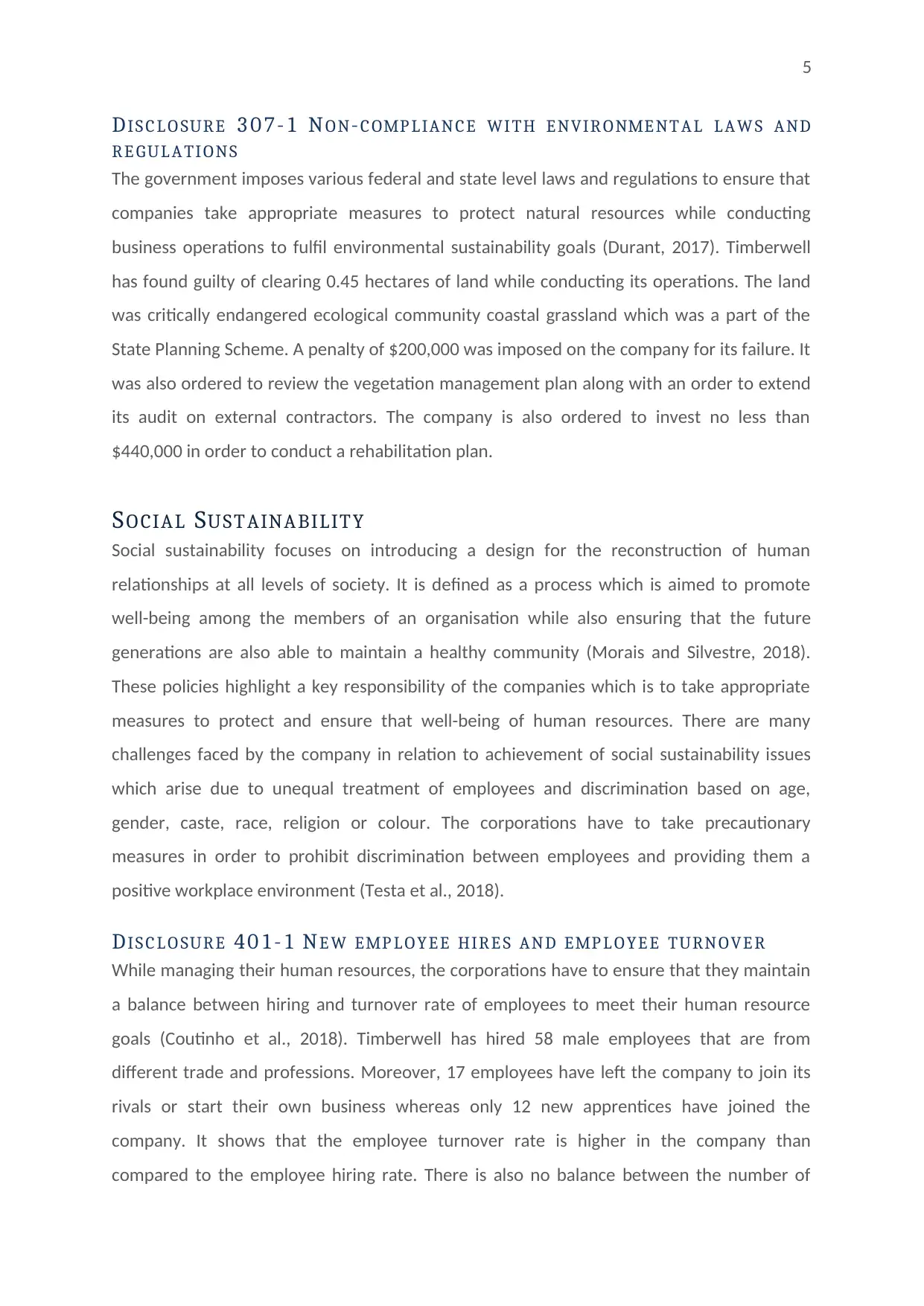
5
DISCLOSURE 307-1 NON-COMPLIANCE WITH ENVIRONMENTAL LAWS AND
REGULATIONS
The government imposes various federal and state level laws and regulations to ensure that
companies take appropriate measures to protect natural resources while conducting
business operations to fulfil environmental sustainability goals (Durant, 2017). Timberwell
has found guilty of clearing 0.45 hectares of land while conducting its operations. The land
was critically endangered ecological community coastal grassland which was a part of the
State Planning Scheme. A penalty of $200,000 was imposed on the company for its failure. It
was also ordered to review the vegetation management plan along with an order to extend
its audit on external contractors. The company is also ordered to invest no less than
$440,000 in order to conduct a rehabilitation plan.
SOCIAL SUSTAINABILITY
Social sustainability focuses on introducing a design for the reconstruction of human
relationships at all levels of society. It is defined as a process which is aimed to promote
well-being among the members of an organisation while also ensuring that the future
generations are also able to maintain a healthy community (Morais and Silvestre, 2018).
These policies highlight a key responsibility of the companies which is to take appropriate
measures to protect and ensure that well-being of human resources. There are many
challenges faced by the company in relation to achievement of social sustainability issues
which arise due to unequal treatment of employees and discrimination based on age,
gender, caste, race, religion or colour. The corporations have to take precautionary
measures in order to prohibit discrimination between employees and providing them a
positive workplace environment (Testa et al., 2018).
DISCLOSURE 401-1 NEW EMPLOYEE HIRES AND EMPLOYEE TURNOVER
While managing their human resources, the corporations have to ensure that they maintain
a balance between hiring and turnover rate of employees to meet their human resource
goals (Coutinho et al., 2018). Timberwell has hired 58 male employees that are from
different trade and professions. Moreover, 17 employees have left the company to join its
rivals or start their own business whereas only 12 new apprentices have joined the
company. It shows that the employee turnover rate is higher in the company than
compared to the employee hiring rate. There is also no balance between the number of
DISCLOSURE 307-1 NON-COMPLIANCE WITH ENVIRONMENTAL LAWS AND
REGULATIONS
The government imposes various federal and state level laws and regulations to ensure that
companies take appropriate measures to protect natural resources while conducting
business operations to fulfil environmental sustainability goals (Durant, 2017). Timberwell
has found guilty of clearing 0.45 hectares of land while conducting its operations. The land
was critically endangered ecological community coastal grassland which was a part of the
State Planning Scheme. A penalty of $200,000 was imposed on the company for its failure. It
was also ordered to review the vegetation management plan along with an order to extend
its audit on external contractors. The company is also ordered to invest no less than
$440,000 in order to conduct a rehabilitation plan.
SOCIAL SUSTAINABILITY
Social sustainability focuses on introducing a design for the reconstruction of human
relationships at all levels of society. It is defined as a process which is aimed to promote
well-being among the members of an organisation while also ensuring that the future
generations are also able to maintain a healthy community (Morais and Silvestre, 2018).
These policies highlight a key responsibility of the companies which is to take appropriate
measures to protect and ensure that well-being of human resources. There are many
challenges faced by the company in relation to achievement of social sustainability issues
which arise due to unequal treatment of employees and discrimination based on age,
gender, caste, race, religion or colour. The corporations have to take precautionary
measures in order to prohibit discrimination between employees and providing them a
positive workplace environment (Testa et al., 2018).
DISCLOSURE 401-1 NEW EMPLOYEE HIRES AND EMPLOYEE TURNOVER
While managing their human resources, the corporations have to ensure that they maintain
a balance between hiring and turnover rate of employees to meet their human resource
goals (Coutinho et al., 2018). Timberwell has hired 58 male employees that are from
different trade and professions. Moreover, 17 employees have left the company to join its
rivals or start their own business whereas only 12 new apprentices have joined the
company. It shows that the employee turnover rate is higher in the company than
compared to the employee hiring rate. There is also no balance between the number of
⊘ This is a preview!⊘
Do you want full access?
Subscribe today to unlock all pages.

Trusted by 1+ million students worldwide
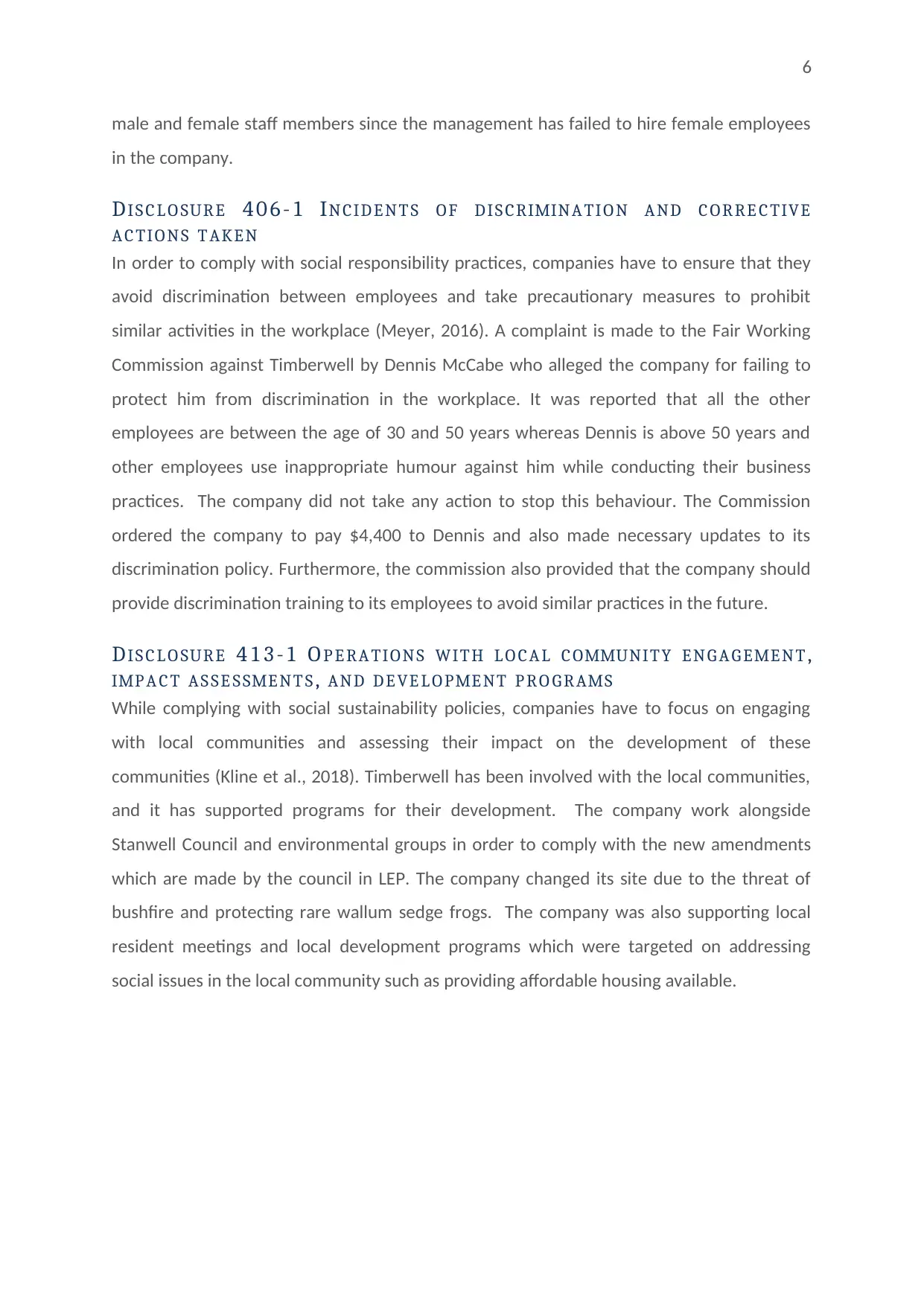
6
male and female staff members since the management has failed to hire female employees
in the company.
DISCLOSURE 406-1 INCIDENTS OF DISCRIMINATION AND CORRECTIVE
ACTIONS TAKEN
In order to comply with social responsibility practices, companies have to ensure that they
avoid discrimination between employees and take precautionary measures to prohibit
similar activities in the workplace (Meyer, 2016). A complaint is made to the Fair Working
Commission against Timberwell by Dennis McCabe who alleged the company for failing to
protect him from discrimination in the workplace. It was reported that all the other
employees are between the age of 30 and 50 years whereas Dennis is above 50 years and
other employees use inappropriate humour against him while conducting their business
practices. The company did not take any action to stop this behaviour. The Commission
ordered the company to pay $4,400 to Dennis and also made necessary updates to its
discrimination policy. Furthermore, the commission also provided that the company should
provide discrimination training to its employees to avoid similar practices in the future.
DISCLOSURE 413-1 OPERATIONS WITH LOCAL COMMUNITY ENGAGEMENT ,
IMPACT ASSESSMENTS , AND DEVELOPMENT PROGRAMS
While complying with social sustainability policies, companies have to focus on engaging
with local communities and assessing their impact on the development of these
communities (Kline et al., 2018). Timberwell has been involved with the local communities,
and it has supported programs for their development. The company work alongside
Stanwell Council and environmental groups in order to comply with the new amendments
which are made by the council in LEP. The company changed its site due to the threat of
bushfire and protecting rare wallum sedge frogs. The company was also supporting local
resident meetings and local development programs which were targeted on addressing
social issues in the local community such as providing affordable housing available.
male and female staff members since the management has failed to hire female employees
in the company.
DISCLOSURE 406-1 INCIDENTS OF DISCRIMINATION AND CORRECTIVE
ACTIONS TAKEN
In order to comply with social responsibility practices, companies have to ensure that they
avoid discrimination between employees and take precautionary measures to prohibit
similar activities in the workplace (Meyer, 2016). A complaint is made to the Fair Working
Commission against Timberwell by Dennis McCabe who alleged the company for failing to
protect him from discrimination in the workplace. It was reported that all the other
employees are between the age of 30 and 50 years whereas Dennis is above 50 years and
other employees use inappropriate humour against him while conducting their business
practices. The company did not take any action to stop this behaviour. The Commission
ordered the company to pay $4,400 to Dennis and also made necessary updates to its
discrimination policy. Furthermore, the commission also provided that the company should
provide discrimination training to its employees to avoid similar practices in the future.
DISCLOSURE 413-1 OPERATIONS WITH LOCAL COMMUNITY ENGAGEMENT ,
IMPACT ASSESSMENTS , AND DEVELOPMENT PROGRAMS
While complying with social sustainability policies, companies have to focus on engaging
with local communities and assessing their impact on the development of these
communities (Kline et al., 2018). Timberwell has been involved with the local communities,
and it has supported programs for their development. The company work alongside
Stanwell Council and environmental groups in order to comply with the new amendments
which are made by the council in LEP. The company changed its site due to the threat of
bushfire and protecting rare wallum sedge frogs. The company was also supporting local
resident meetings and local development programs which were targeted on addressing
social issues in the local community such as providing affordable housing available.
Paraphrase This Document
Need a fresh take? Get an instant paraphrase of this document with our AI Paraphraser
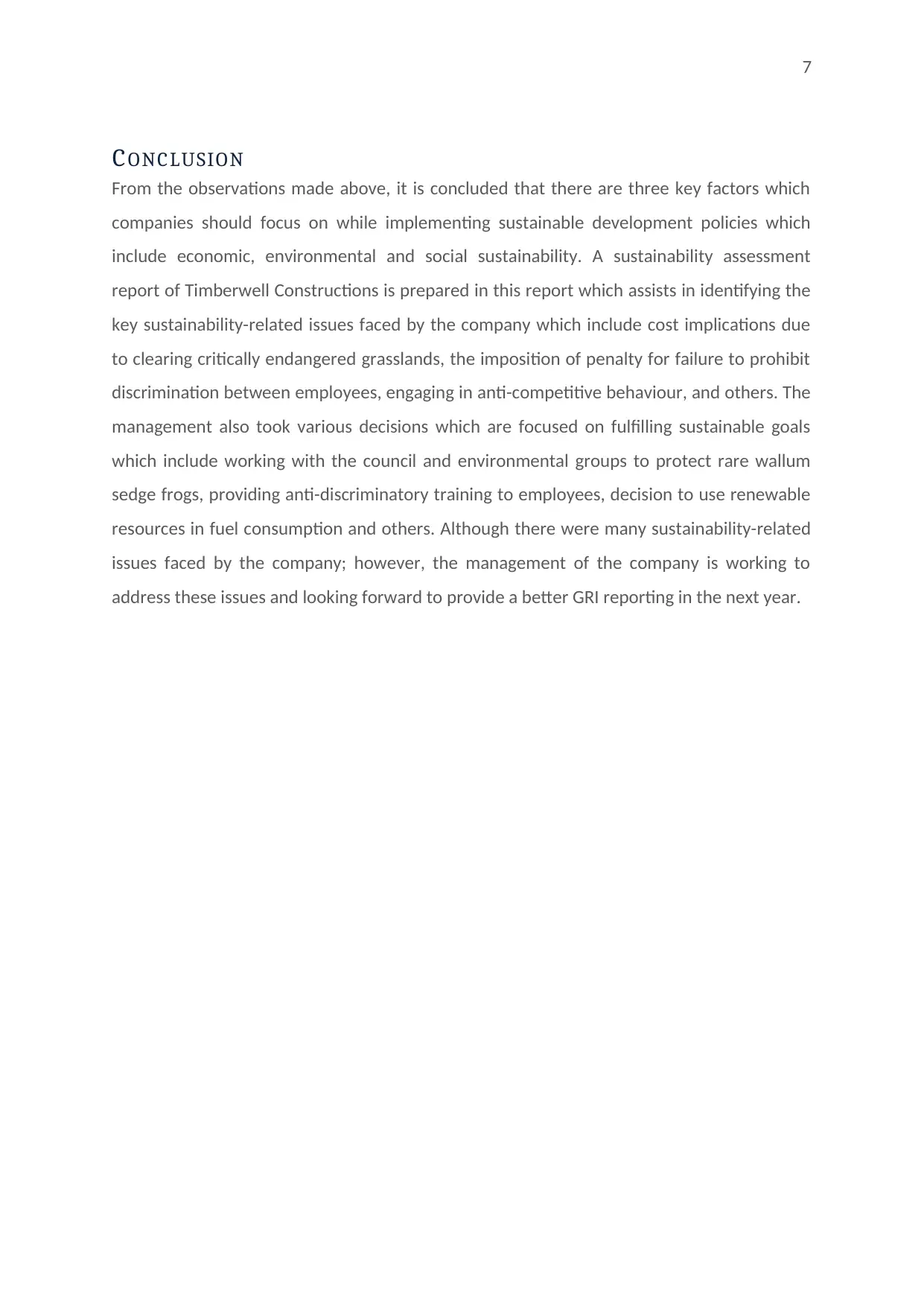
7
CONCLUSION
From the observations made above, it is concluded that there are three key factors which
companies should focus on while implementing sustainable development policies which
include economic, environmental and social sustainability. A sustainability assessment
report of Timberwell Constructions is prepared in this report which assists in identifying the
key sustainability-related issues faced by the company which include cost implications due
to clearing critically endangered grasslands, the imposition of penalty for failure to prohibit
discrimination between employees, engaging in anti-competitive behaviour, and others. The
management also took various decisions which are focused on fulfilling sustainable goals
which include working with the council and environmental groups to protect rare wallum
sedge frogs, providing anti-discriminatory training to employees, decision to use renewable
resources in fuel consumption and others. Although there were many sustainability-related
issues faced by the company; however, the management of the company is working to
address these issues and looking forward to provide a better GRI reporting in the next year.
CONCLUSION
From the observations made above, it is concluded that there are three key factors which
companies should focus on while implementing sustainable development policies which
include economic, environmental and social sustainability. A sustainability assessment
report of Timberwell Constructions is prepared in this report which assists in identifying the
key sustainability-related issues faced by the company which include cost implications due
to clearing critically endangered grasslands, the imposition of penalty for failure to prohibit
discrimination between employees, engaging in anti-competitive behaviour, and others. The
management also took various decisions which are focused on fulfilling sustainable goals
which include working with the council and environmental groups to protect rare wallum
sedge frogs, providing anti-discriminatory training to employees, decision to use renewable
resources in fuel consumption and others. Although there were many sustainability-related
issues faced by the company; however, the management of the company is working to
address these issues and looking forward to provide a better GRI reporting in the next year.
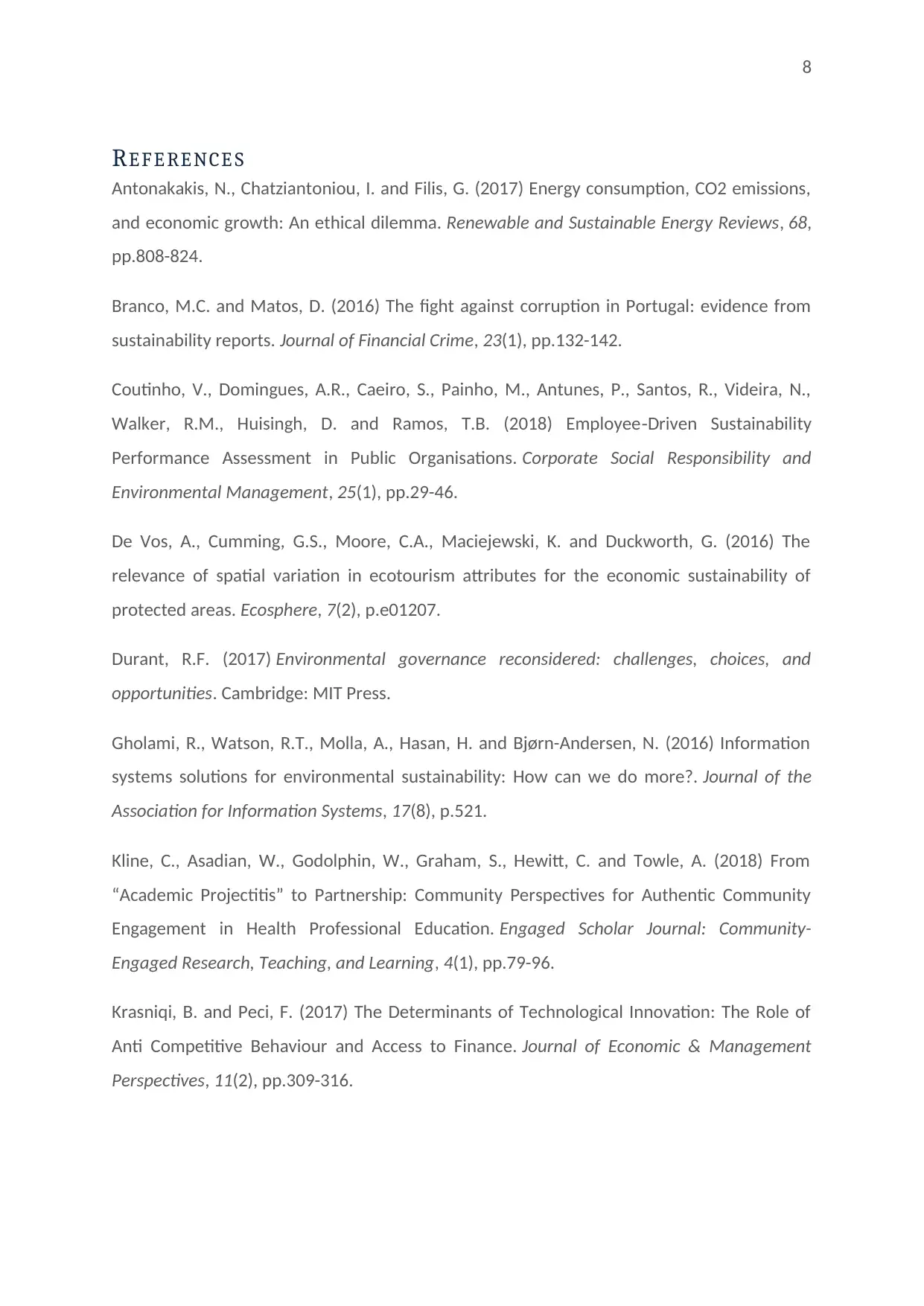
8
REFERENCES
Antonakakis, N., Chatziantoniou, I. and Filis, G. (2017) Energy consumption, CO2 emissions,
and economic growth: An ethical dilemma. Renewable and Sustainable Energy Reviews, 68,
pp.808-824.
Branco, M.C. and Matos, D. (2016) The fight against corruption in Portugal: evidence from
sustainability reports. Journal of Financial Crime, 23(1), pp.132-142.
Coutinho, V., Domingues, A.R., Caeiro, S., Painho, M., Antunes, P., Santos, R., Videira, N.,
Walker, R.M., Huisingh, D. and Ramos, T.B. (2018) Employee‐Driven Sustainability
Performance Assessment in Public Organisations. Corporate Social Responsibility and
Environmental Management, 25(1), pp.29-46.
De Vos, A., Cumming, G.S., Moore, C.A., Maciejewski, K. and Duckworth, G. (2016) The
relevance of spatial variation in ecotourism attributes for the economic sustainability of
protected areas. Ecosphere, 7(2), p.e01207.
Durant, R.F. (2017) Environmental governance reconsidered: challenges, choices, and
opportunities. Cambridge: MIT Press.
Gholami, R., Watson, R.T., Molla, A., Hasan, H. and Bjørn-Andersen, N. (2016) Information
systems solutions for environmental sustainability: How can we do more?. Journal of the
Association for Information Systems, 17(8), p.521.
Kline, C., Asadian, W., Godolphin, W., Graham, S., Hewitt, C. and Towle, A. (2018) From
“Academic Projectitis” to Partnership: Community Perspectives for Authentic Community
Engagement in Health Professional Education. Engaged Scholar Journal: Community-
Engaged Research, Teaching, and Learning, 4(1), pp.79-96.
Krasniqi, B. and Peci, F. (2017) The Determinants of Technological Innovation: The Role of
Anti Competitive Behaviour and Access to Finance. Journal of Economic & Management
Perspectives, 11(2), pp.309-316.
REFERENCES
Antonakakis, N., Chatziantoniou, I. and Filis, G. (2017) Energy consumption, CO2 emissions,
and economic growth: An ethical dilemma. Renewable and Sustainable Energy Reviews, 68,
pp.808-824.
Branco, M.C. and Matos, D. (2016) The fight against corruption in Portugal: evidence from
sustainability reports. Journal of Financial Crime, 23(1), pp.132-142.
Coutinho, V., Domingues, A.R., Caeiro, S., Painho, M., Antunes, P., Santos, R., Videira, N.,
Walker, R.M., Huisingh, D. and Ramos, T.B. (2018) Employee‐Driven Sustainability
Performance Assessment in Public Organisations. Corporate Social Responsibility and
Environmental Management, 25(1), pp.29-46.
De Vos, A., Cumming, G.S., Moore, C.A., Maciejewski, K. and Duckworth, G. (2016) The
relevance of spatial variation in ecotourism attributes for the economic sustainability of
protected areas. Ecosphere, 7(2), p.e01207.
Durant, R.F. (2017) Environmental governance reconsidered: challenges, choices, and
opportunities. Cambridge: MIT Press.
Gholami, R., Watson, R.T., Molla, A., Hasan, H. and Bjørn-Andersen, N. (2016) Information
systems solutions for environmental sustainability: How can we do more?. Journal of the
Association for Information Systems, 17(8), p.521.
Kline, C., Asadian, W., Godolphin, W., Graham, S., Hewitt, C. and Towle, A. (2018) From
“Academic Projectitis” to Partnership: Community Perspectives for Authentic Community
Engagement in Health Professional Education. Engaged Scholar Journal: Community-
Engaged Research, Teaching, and Learning, 4(1), pp.79-96.
Krasniqi, B. and Peci, F. (2017) The Determinants of Technological Innovation: The Role of
Anti Competitive Behaviour and Access to Finance. Journal of Economic & Management
Perspectives, 11(2), pp.309-316.
⊘ This is a preview!⊘
Do you want full access?
Subscribe today to unlock all pages.

Trusted by 1+ million students worldwide
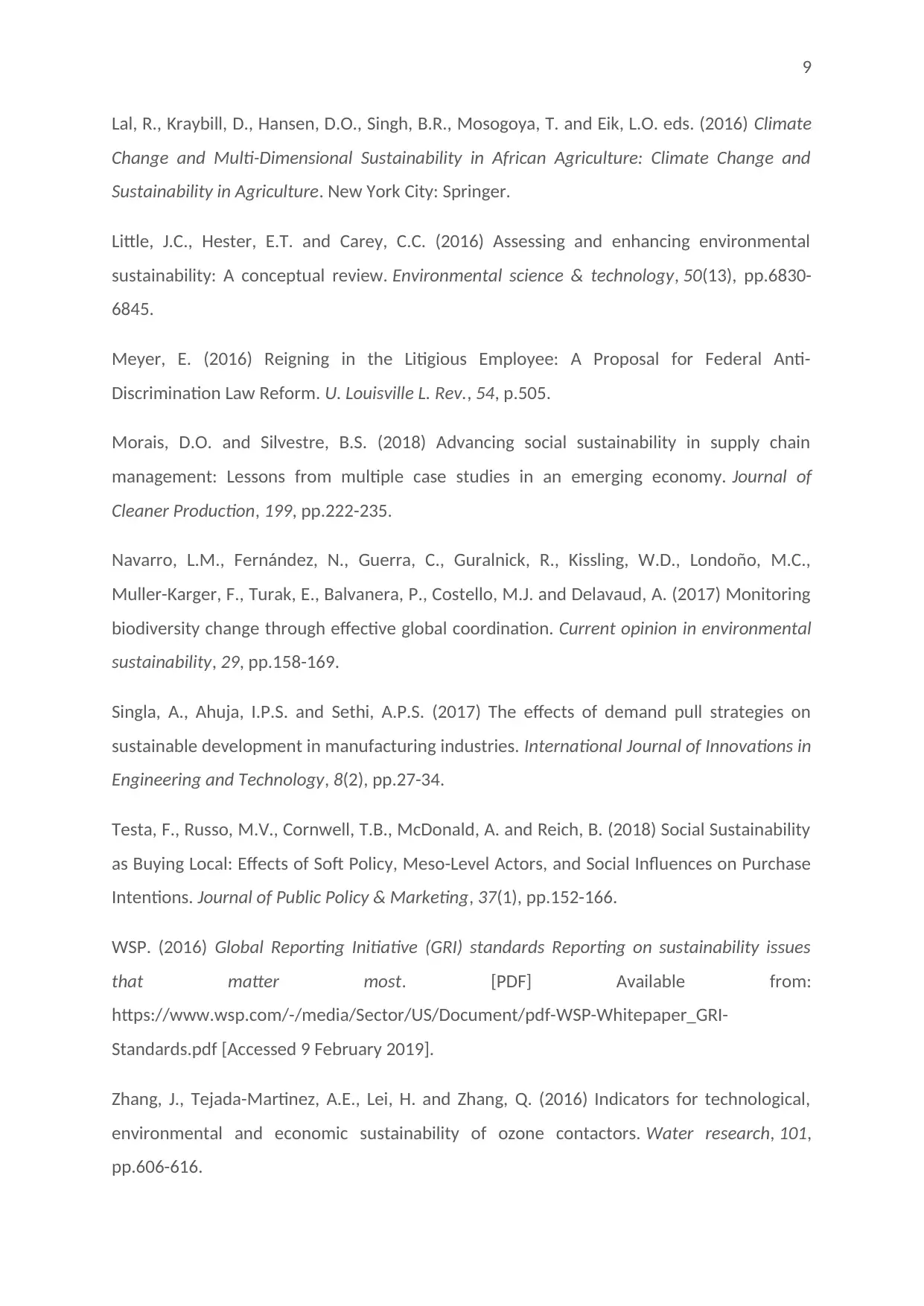
9
Lal, R., Kraybill, D., Hansen, D.O., Singh, B.R., Mosogoya, T. and Eik, L.O. eds. (2016) Climate
Change and Multi-Dimensional Sustainability in African Agriculture: Climate Change and
Sustainability in Agriculture. New York City: Springer.
Little, J.C., Hester, E.T. and Carey, C.C. (2016) Assessing and enhancing environmental
sustainability: A conceptual review. Environmental science & technology, 50(13), pp.6830-
6845.
Meyer, E. (2016) Reigning in the Litigious Employee: A Proposal for Federal Anti-
Discrimination Law Reform. U. Louisville L. Rev., 54, p.505.
Morais, D.O. and Silvestre, B.S. (2018) Advancing social sustainability in supply chain
management: Lessons from multiple case studies in an emerging economy. Journal of
Cleaner Production, 199, pp.222-235.
Navarro, L.M., Fernández, N., Guerra, C., Guralnick, R., Kissling, W.D., Londoño, M.C.,
Muller-Karger, F., Turak, E., Balvanera, P., Costello, M.J. and Delavaud, A. (2017) Monitoring
biodiversity change through effective global coordination. Current opinion in environmental
sustainability, 29, pp.158-169.
Singla, A., Ahuja, I.P.S. and Sethi, A.P.S. (2017) The effects of demand pull strategies on
sustainable development in manufacturing industries. International Journal of Innovations in
Engineering and Technology, 8(2), pp.27-34.
Testa, F., Russo, M.V., Cornwell, T.B., McDonald, A. and Reich, B. (2018) Social Sustainability
as Buying Local: Effects of Soft Policy, Meso-Level Actors, and Social Influences on Purchase
Intentions. Journal of Public Policy & Marketing, 37(1), pp.152-166.
WSP. (2016) Global Reporting Initiative (GRI) standards Reporting on sustainability issues
that matter most. [PDF] Available from:
https://www.wsp.com/-/media/Sector/US/Document/pdf-WSP-Whitepaper_GRI-
Standards.pdf [Accessed 9 February 2019].
Zhang, J., Tejada-Martinez, A.E., Lei, H. and Zhang, Q. (2016) Indicators for technological,
environmental and economic sustainability of ozone contactors. Water research, 101,
pp.606-616.
Lal, R., Kraybill, D., Hansen, D.O., Singh, B.R., Mosogoya, T. and Eik, L.O. eds. (2016) Climate
Change and Multi-Dimensional Sustainability in African Agriculture: Climate Change and
Sustainability in Agriculture. New York City: Springer.
Little, J.C., Hester, E.T. and Carey, C.C. (2016) Assessing and enhancing environmental
sustainability: A conceptual review. Environmental science & technology, 50(13), pp.6830-
6845.
Meyer, E. (2016) Reigning in the Litigious Employee: A Proposal for Federal Anti-
Discrimination Law Reform. U. Louisville L. Rev., 54, p.505.
Morais, D.O. and Silvestre, B.S. (2018) Advancing social sustainability in supply chain
management: Lessons from multiple case studies in an emerging economy. Journal of
Cleaner Production, 199, pp.222-235.
Navarro, L.M., Fernández, N., Guerra, C., Guralnick, R., Kissling, W.D., Londoño, M.C.,
Muller-Karger, F., Turak, E., Balvanera, P., Costello, M.J. and Delavaud, A. (2017) Monitoring
biodiversity change through effective global coordination. Current opinion in environmental
sustainability, 29, pp.158-169.
Singla, A., Ahuja, I.P.S. and Sethi, A.P.S. (2017) The effects of demand pull strategies on
sustainable development in manufacturing industries. International Journal of Innovations in
Engineering and Technology, 8(2), pp.27-34.
Testa, F., Russo, M.V., Cornwell, T.B., McDonald, A. and Reich, B. (2018) Social Sustainability
as Buying Local: Effects of Soft Policy, Meso-Level Actors, and Social Influences on Purchase
Intentions. Journal of Public Policy & Marketing, 37(1), pp.152-166.
WSP. (2016) Global Reporting Initiative (GRI) standards Reporting on sustainability issues
that matter most. [PDF] Available from:
https://www.wsp.com/-/media/Sector/US/Document/pdf-WSP-Whitepaper_GRI-
Standards.pdf [Accessed 9 February 2019].
Zhang, J., Tejada-Martinez, A.E., Lei, H. and Zhang, Q. (2016) Indicators for technological,
environmental and economic sustainability of ozone contactors. Water research, 101,
pp.606-616.
Paraphrase This Document
Need a fresh take? Get an instant paraphrase of this document with our AI Paraphraser

10
1 out of 11
Related Documents
Your All-in-One AI-Powered Toolkit for Academic Success.
+13062052269
info@desklib.com
Available 24*7 on WhatsApp / Email
![[object Object]](/_next/static/media/star-bottom.7253800d.svg)
Unlock your academic potential
Copyright © 2020–2025 A2Z Services. All Rights Reserved. Developed and managed by ZUCOL.





